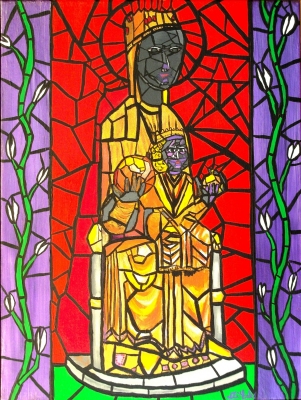

       |
| All
Things in Christ
Anne
Wetzel, Curator presented June 21, 2006 |
|
| |
| |

|
|
Black
Madonna of Catalonia
by Gerard DiFalco
(Painting, 2005,
24" x 18")
St. Clement's Church - Philadelphia,
PA
gerarddifalco@msn.com
|
My journey into Spiritual and Iconographic Art began in
1992 when I was diagnosed with Degenerative Disc Disease
and RSD (Severe Chronic Pain Syndrome). I needed to motivated
my studio endeavors with more than visual pursuits, and
found this outlet in expressing Divinity in my art. I
do not see my Icons as idolatry; rather, I hope these
works inspire viewers to find Christ within their own
lives and hearts. Also, in the early history of iconography,
not all people were literate; now, even though most people
read, I believe that many do not digest what they read
as a result of the electronic media's prominence in today's
communicational stratification. Therefore, I hope that
my spiritual visual works enable the stories they represent
to convey a sincere humanism.
These Madonna Paintings all represent the importance of
women in the fabric of civilization and in Christianity,
a new religion that evolved from Judaic religious law
that was, for the most part, quite misogynistic. Christ
gave us one law, which was to love one another. What his
disciples (all Hebrews who were raised on Hebrew Law)
did after his departure (and what was decided at the Council
of Nicea 300 years AD) perhaps had very little to do with
how Jesus really felt about women. My Madonnas are not
just symbols of the human procreative force and woman's
major role in that; rather, my "Ladys". Mothers",
and "Female Saint" Icons are statements of the
Divine Nature of Women in Her role as teacher (rabbi or
priest included), healer, provider, ruler of the young,
artist, story-teller, warrior, farmer, and magician (to
kiss a boo-boo on a child is very strong magic). I also
see women as a mediator between men and God's law of Love,
the weavers of the neo-wisdom in our post-messianic era,
which has lasted over 2,000 years. pace. It is a direct
answer to the prayer for spiritual sight and a hint of
the immenseness and power of “all things”
growing “into . . . Christ.”
|
|
|
|
|
|
| |
| |
| |
| |
| |
| |
| |
| |
| |
| |
| |
| |
| |
| |
|
![]()